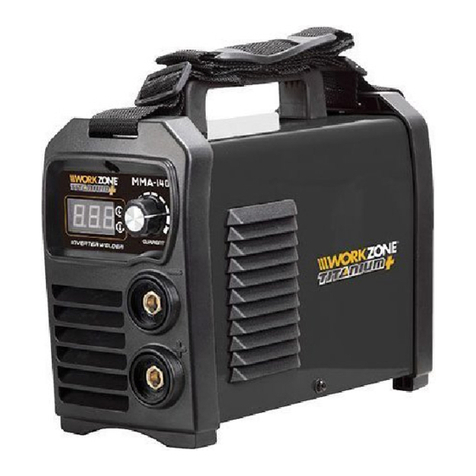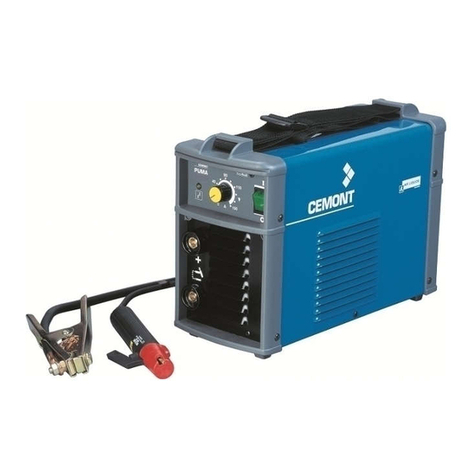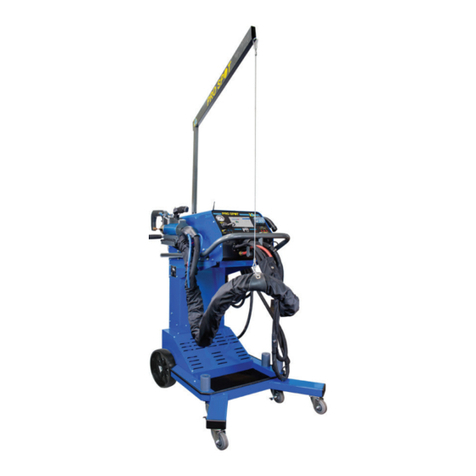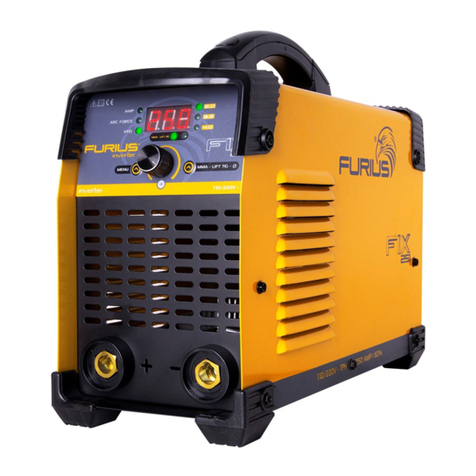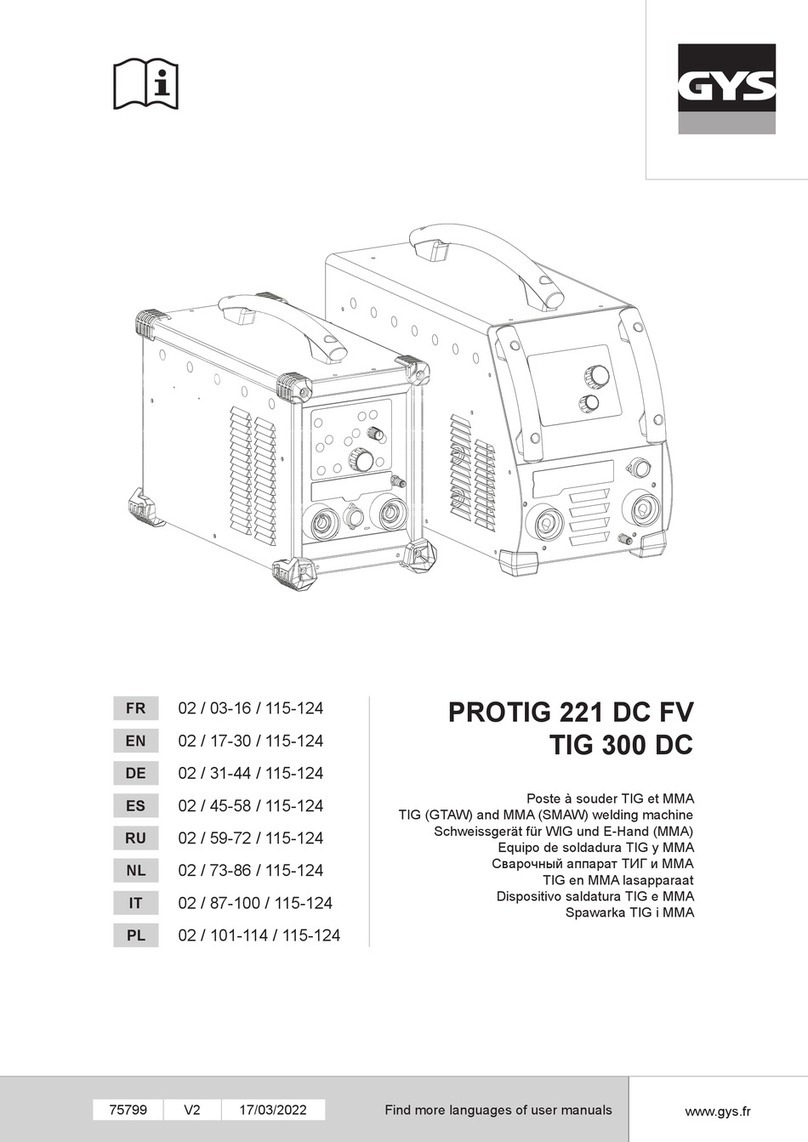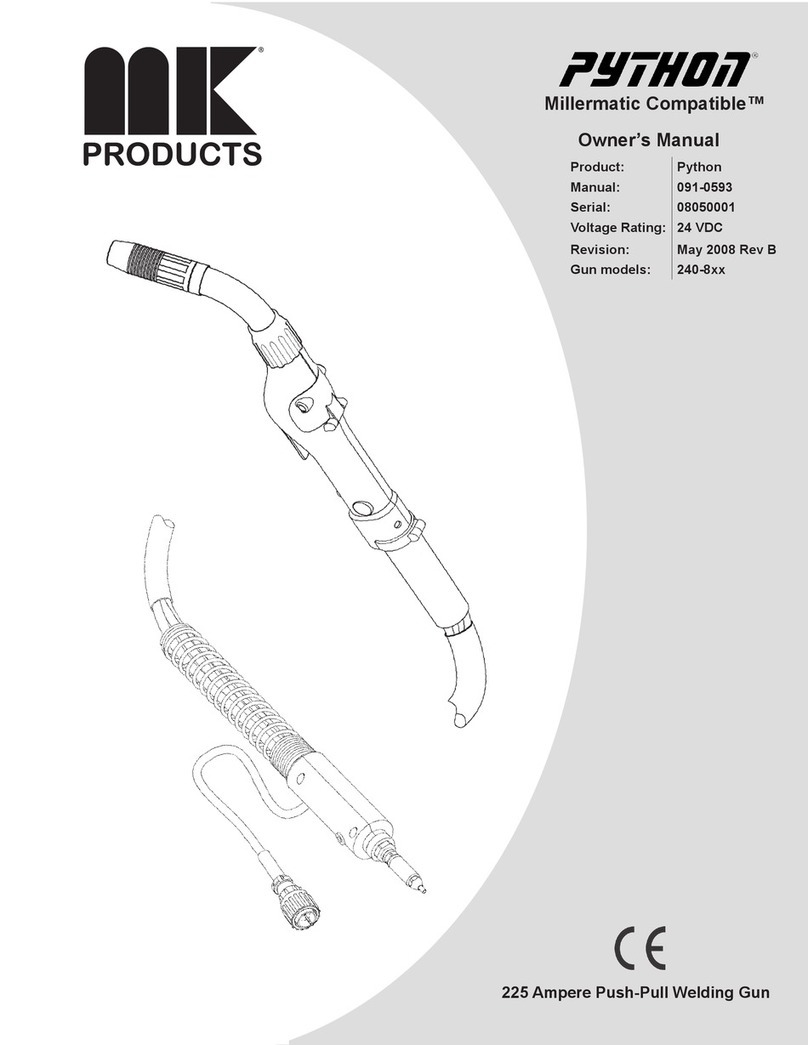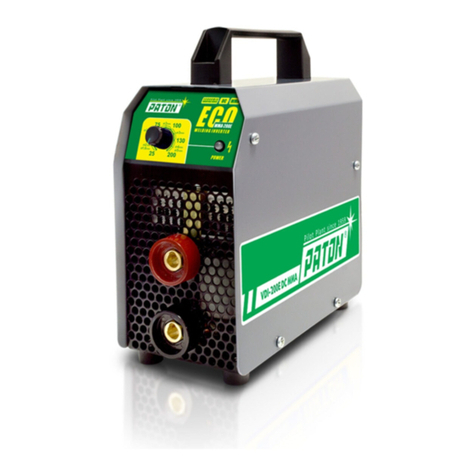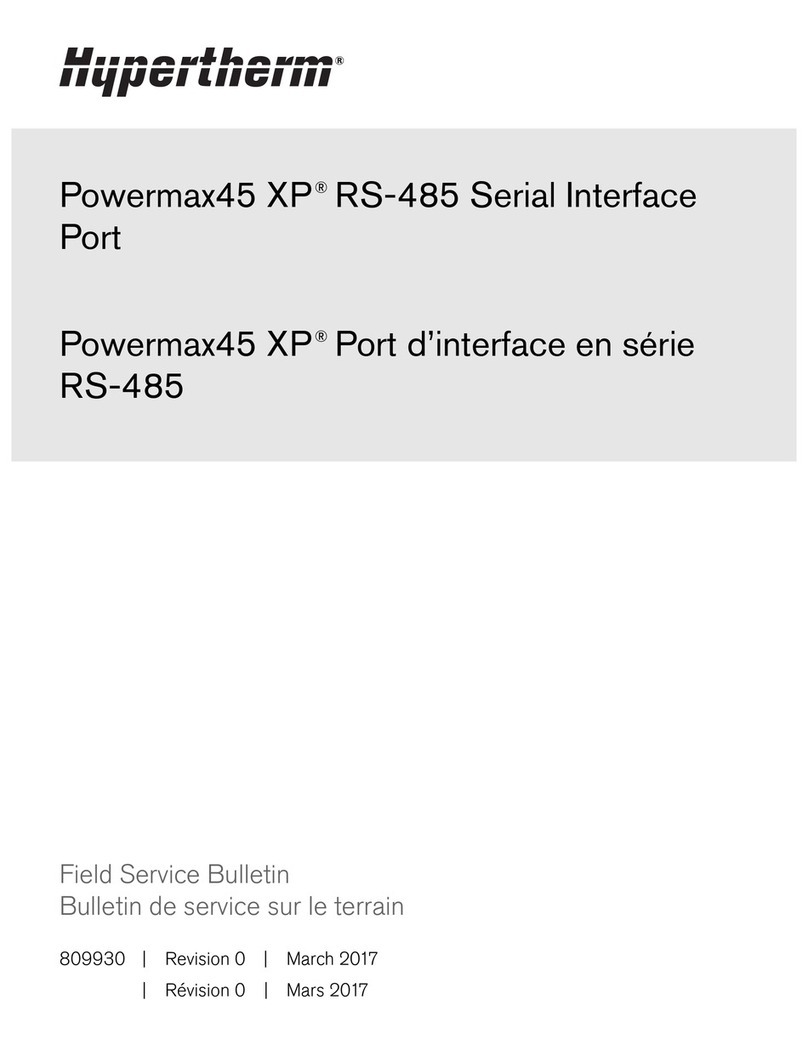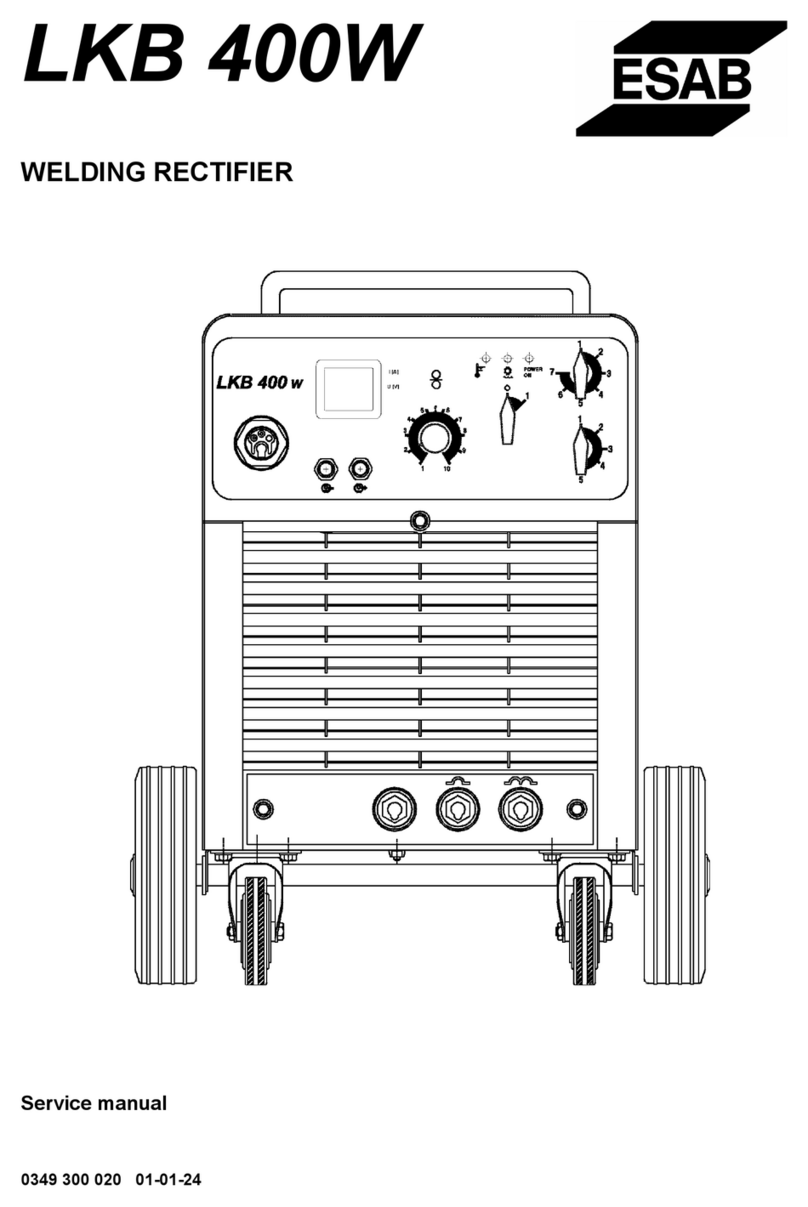Workzone WZAW 150 User manual

Now you have purchased a Workzone® product you
can rest assured in the knowledge that as well as your
3 year parts and labour guarantee you have the added
peace of mind of dedicated helplines and web support.
MODEL: WZAW 150, 10/2013
ARC WELDER
OPERATING INSTRUCTIONS USER GUIDE

2
Contents
1Welcome
2General Information and Safety Instructions
3Assembly and Parts List
4Getting Started
5Features
6Instructions
7FAQ
8Warranty Card
GB IRE WZAW 1500151 649 1500 1890 946 244 www.einhell.co.ukAFTER SALES SUPPORT

3
Welcome 1
Congratulations!
You have made an excellent choice with the purchase of this
quality Workzone® product.
By doing so you now have the assurance and peace of mind which comes
from purchasing a product that has been manufactured to the highest
standards of performance and safety, supported by the high quality
standards of ALDI.
We want you to be completely satised with your purchase so
this Workzone® product is backed by a comprehensive manufacturer’s
3 year warranty and an outstanding after sales service through our
dedicated Helpline.
We hope you will enjoy using your purchase for many years to come.
If you require technical support or in the unlikely event that your purchase
is faulty please telephone our Helpline for immediate assistance. Faulty
product claims made within the 3 year warranty period will be repaired
or replaced free of charge provided that you have satisfactory proof of
purchase (keep your till receipt safe!). This does not aect
your statutory rights. However, be aware that the warranty will
become null and void if the product is found to have been
deliberately damaged, misused or disassembled.
GB IRE WZAW 1500151 649 1500 1890 946 244 www.einhell.co.ukAFTER SALES SUPPORT

4
General Information
and Safety Instructions 2
IMPORTANT: When using the equipment, a few safety precautions
must be observed to avoid injuries and damage. Please read the
complete operating instructions and safety regulations with due care.
Keep this manual in a safe place, so that the information is available at
all times. If you give the equipment to any other person hand over these
operating instructions and safety regulations as well. We cannot accept
any liability for damage or accidents which arise due to a failure to follow
these instructions and the safety instructions.
Important information
Please read the operating instructions carefully and observe the
information provided. It is important to consult these instructions
in order to acquaint yourself with the equipment, its proper use and
safety information.
IMPORTANT: Only use this appliance for the purpose for which it is
designed and as described in these instructions: Manual arc welding
with coated electrodes. Handling this system incorrectly may be
hazardous for persons, animals and property. The user of this system
is responsible for their own safety and for the safety of others.
Read these operating instructions and follow all the regulations.
Electrical safety
•Repairs and/or maintenance work may only be carried out by
qualied personnel.
•Use only the power cables and welding cables supplied.
•Ensure that the appliance is looked after properly.
GB IRE WZAW 1500151 649 1500 1890 946 244 www.einhell.co.ukAFTER SALES SUPPORT

5
•To ensure that sucient air can be drawn in through the ventilation slits,
the appliance should not be constricted or placed next to a wall while it
is operating. Make sure that the appliance is correctly connected to the
mains supply. Do not subject the mains lead to any tensile stress.
Unplug the appliance before you change its position.
•Check the condition of the welding cables, the electrode tongs and the
earth terminals (-); wear on the insulation and the live parts may result
in dangerous conditions and reduce the quality of the welding work.
•Arc welding generates sparks, molten metal particles and smoke, so the
following is required: Remove all inammable substances and/or materials
from the working area.
•Ensure that there is adequate ventilation.
•Do not weld on tanks, vessels or pipes that have contained inammable
liquids or gases. Avoid all direct contact with the welding circuit; the idling
voltage between the electrode tongs and the earth terminal (-) may
be dangerous.
•Do not store or use the appliance in wet or damp conditions or in the rain.
•Protect your eyes with specially designed goggles (DIN level 9-10), which
you can attach to the supplied safety shield. Wear gloves and dry safety
clothing that are not contaminated by any oil or grease to ensure that
your skin is not exposed to ultraviolet radiation from the arc.
HAZARD:
• Do not use this welder to defrost pipes.
• Make sure that the equipment is set up so it stands rmly.
• The radiation from the arc can damage your eyes and cause
burns on skin.
• Arc welding generates sparks and droplets of molten metal;
the welded workpiece may start to glow and will remain very
hot for a relatively long period of time.
• Arc welding releases vapours that may be harmful.
• Every electric shock is potentially fatal.
• Do not approach the arc within a radius of 15 m unprotected.
• Protect yourself (and others around you) against the possible
hazardous eects of the arc.
General Information
and Safety Instructions 2
GB IRE WZAW 1500151 649 1500 1890 946 244 www.einhell.co.ukAFTER SALES SUPPORT

6
WARNING: Depending on the mains connection conditions at the
connection point of the welding set, other consumers connected
to the mains may suer faults.
IMPORTANT: If the supply mains and circuits are overloaded,
other consumers may suer interference during the welding work.
If you have any doubts, contact your electricity supply company.
Proper use
The machine is to be used only for its prescribed purpose. Any other
use is deemed to be a case of misuse. The user / operator and not the
manufacturer will be liable for any damage or injuries of any kind caused
as a result of this. Please note that our equipment has not been designed
for use in commercial, trade or industrial applications. Our warranty will be
voided if the machine is used in commercial, trade or industrial businesses
or for equivalent purposes.
Sources of danger during arc welding
Arc welding results in a number of sources of danger. It is therefore
particularly important for the welder to comply with the following rules so
as not to place them or others in danger and to avoid endangering people
and equipment.
•Have all work on the mains voltage system, for example on cables, plugs,
sockets, etc., performed only by trained electricians. This particularly
applies to conguring intermediate cables.
•If an accident occurs, disconnect the welding power source from the
mains immediately.
•If electric touch voltages occur, switch o the welding set immediately
and have it checked by an expert.
•Always check for good electrical contacts on the welding current side.
General Information
and Safety Instructions 2
GB IRE WZAW 1500151 649 1500 1890 946 244 www.einhell.co.ukAFTER SALES SUPPORT

7
•Wear insulating gloves on both hands for welding. These oer protection
from electric shocks (idling voltage in the welding circuit), harmful
radiation (Heat and UV radiation) and from glowing metal and slag spatter.
•Wear rm, insulated footwear. Your shoes should also protect you in wet
conditions. Open toed footwear is not suitable since falling droplets of
glowing metal will cause burns.
•Wear suitable clothing, do not wear synthetic clothes.
•Do not look into the arc with unprotected eyes, use only a face shield with
the proper safety glass in compliance with DIN standards. In addition to
light and heat, which may cause dazzling and burns, the arc also gives o
UV radiation. Without proper protection, this invisible ultraviolet radiation
causes very painful conjunctivitis, which will only be noticeable several
hours later. In addition, UV radiation will cause
sunburn-type symptoms on unprotected parts of the body.
•Personnel or assistants in the vicinity of the arc must also be notied of
the dangers and provided with the required protection; if necessary install
safety walls.
•Ensure adequate ventilation for welding, particularly in small rooms since
the process causes smoke and harmful gases.
•Do not carry out any welding work on tanks that have been used to
store gases, fuels, mineral oil or the like, even if they have been empty
for a lengthy period of time, since any residue will result in a danger
of explosion.
•Special regulations apply in areas where there is a potential risk of re
and/or explosion.
•Welds that are exposed to large stresses and must comply with safety
requirements may only be completed by specially trained and approved
welders. Examples of such welds include pressure vessels, rails, trailer
hitches, etc.
General Information
and Safety Instructions 2
GB IRE WZAW 1500151 649 1500 1890 946 244 www.einhell.co.ukAFTER SALES SUPPORT

8
General Information
and Safety Instructions 2
IMPORTANT: It must be noted that the protective conductor in
electrical systems of appliances may be destroyed by the welding
current in the event of negligence, for example if the earth terminal
is placed on the welding set casing to which the protective conductor
of the electrical system is connected. The welding work is completed
on a machine with a protective conductor connection. It is therefore
possible to weld on the machine without having connected the
earth terminal to it. In this case the welding current will ow from
the earth terminal through the protective conductor to the machine.
The high welding current may cause the protective conductor
to melt.
•Only t a 13A fuse in the 13A plug tted to the supply cable for this welder.
Unplug the appliance before you change its position.
Constricted and wet areas
CAUTION: When working in constricted, wet or hot areas, use insulating
supports and intermediate layers as well as slip-on gloves made of
leather or other non-conductive materials to insulate your body against
the oor, walls, conductive parts of the machine and the like. If you
use small welding transformers for welding in places with an increase
electrical risk, for example in constricted areas with conductive walls,
(tanks, pipes, etc.), in wet areas (which make work clothes wet) and in
hot areas (perspiration on work clothes), the output voltage of the
welding set when idling must not exceed 48 V (eective value).
Therefore, the appliance may not be used for these purposes because
its output voltage is higher than this.
GB IRE WZAW 1500151 649 1500 1890 946 244 www.einhell.co.ukAFTER SALES SUPPORT

9
GB IRE WZAW 1500151 649 1500 1890 946 244 www.einhell.co.ukAFTER SALES SUPPORT
General Information
and Safety Instructions 2
Safety clothing
CAUTION:
• While working, the welder must protect their entire body from
radiation and burns by wearing suitable clothing and a face guard.
• Slip-on gloves made of a suitable material (leather) must be worn
on both hands. They must be in perfect condition.
• Suitable aprons must be worn to protect clothing from sparks and
burns. A safety suit and, if necessary, head protection must be worn
if required by the type of work in question, e.g. overhead welding.
• The protective clothing used as well as all accessories must be in
compliance with the “Personal safety equipment” EU Directive.
Protection from radiation and burns
CAUTION:
• Provide information about the risk to eyes at the working site in
the form of a poster with the wording “Caution – do not look at the
ames”. Workplaces are to be screened o wherever possible so that
personnel in the vicinity are protected. Unauthorised persons are to
be kept away from the welding work.
• The walls in the immediate vicinity of stationary workplaces should
not have a light colour or a sheen. Windows up to head height are to
be protected against radiation passing through them or reecting
o them, for example by coating them with a suitable paint.
Do not store or use the equipment in wet conditions
or in the rain. Use the equipment only indoors.

10
GB IRE WZAW 1500151 649 1500 1890 946 244 www.einhell.co.ukAFTER SALES SUPPORT
General Information
and Safety Instructions 2
Symbols and technical data
EN 60974-6 European standard for arc welding sets and welding
power supplies with limited on time (Part 6).
Symbol for welding power supplies which are
suitable for welding in environments with increased
electrical danger.
U0Rated idling voltage [V].
~ 50 Hz Alternating current and rated frequency value [Hz].
80 A/ 21,2 V Maximum welding current and the corresponding
standardized operating voltage [A/V].
ØElectrode diameter [mm].
I2Welding current [A].
twAverage load time [s].
trAverage reset time [s].
Line input; number of phases, the alternating
current symbol and the rated frequency value.
U1Line voltage [V].
I1max Highest rated value of the line current [A].
I1e Eective value of the highest line current [A].
IP 21 S Protection type.
HInsulation class.
Electrode holder connection.
Ground terminal connection.
Control lamp for overheating.
1 ~ 50 Hz

11
GB IRE WZAW 1500151 649 1500 1890 946 244 www.einhell.co.ukAFTER SALES SUPPORT
Assembly and Parts List 3
Fig 2 K L M
N
O
P
Q
SR
Fig 3
M
K L
Fig 1 7
2
3
5
6
4
8
1
9

12
Assembly and Parts List 3
GB IRE WZAW 1500151 649 1500 1890 946 244 www.einhell.co.ukAFTER SALES SUPPORT
Fig 4
Q Q
S
Fig 6 Fig 7
Fig 8 Fig 9
Fig 5
K, L, M
N
N
Q
1.
2.
S
3.
4.
P
P
P
O
O P
R

13
GB IRE WZAW 1500151 649 1500 1890 946 244 www.einhell.co.ukAFTER SALES SUPPORT
Getting Started 4
Layout (Fig. 1/2)
1. Electrode holder
2. Earth terminal
3. Adjustment wheel for welding current
4. ON/OFF switch
5. Control lamp for overheating
6. Welding current scale
7. Carry handle
8. Face shield
9. 2 in 1 wire brush / chipping hammer
K. Safety glass frame
L. Welding glass
M. Safety glass
N. Safety glass retaining bushes
O. Nuts for handle
P. Screws for handle
Q. Safety glass retaining pins
R. Handle
S. Face shield frame
Items supplied (Fig. 1/2)
1. Welding set
2. Face shield parts
3. State 2 in 1 wire brush / chipping hammer

Welding preparations
Connect the earth terminal (-) (2) direct to the part to be welded or to the
support on which the part is resting. Ensure that the earth terminal (-) is
in direct contact with the part to be welded. You should therefore avoid
coated surfaces and/or insulated materials. The electrode holder cable
has a special clamp at one end, which is used to secure the electrode.
The face shield must be used at all times for welding. It protects your eyes
from the radiation emitted by the arc and nevertheless enables you to
watch the welding process.
Assembling the face shield (Fig. 3-9)
• Place the welding glass (l) and the transparent safety glass (m) over it in the
frame for the safety glass (k) (Fig. 3).
• Press the safety glass retaining pins (q) into the holes in face shield frame (s)
from the outside (Fig. 4).
• Place the frame for the safety glass (k) with the welding glass (l) and
transparent safety glass (m) from the inside into the recess in the welding
frame (s), press the safety glass retaining bushes (n) onto the safety glass
retaining pins (q) until they engage to secure the frame for the safety glass
(k). The transparent safety glass (m) must be on the outside (Fig. 5).
• Bend the top of the face shield frame (s) inwards (Fig. 6/1) and fold down the
top corners (Fig. 6/2). Now bend the outer sides of the face shield frame (s)
inwards (Fig. 6/3) and connect them by pressing the top corners and outer
sides together. When the retaining pins engage, you should be able to hear
2 clear clicks on each side (Fig. 6/4).
• When the top corners of the face shield are connected as shown in Figure 7,
place the screws for the handle (p) from the outside through the three holes
in the face shield (Fig. 8).
• Turn over the face shield and place the handle (r) over the threads on the
three screws for the handle (p). Secure the handle (r) to the face shield using
the three nuts for the handle (o) (Fig. 9).
Getting Started 4
15
14

15
GB IRE WZAW 1500151 649 1500 1890 946 244 www.einhell.co.ukAFTER SALES SUPPORT
Features 5
r
2
w
Technical data
Mains connection 230 V ~ 50 Hz
Welding current (A) at COS Φ = 0.73: 40 - 80
ø (mm)
l
t (s)
t (s)
Idling voltage (V): 48
Power input: 4 kVA at 80 A COS Φ= 0.73
Fuse (A): 13
1.6 2.0 2.5
40 55 80
217 116 64
1450 1381 1351
The welding times apply for an ambient temperature of 40°C electrical
connections for the power supply
Spare parts and consumables
EUK CODE TBC
1592700 EUK CODE TBC
1592500 EUK CODE TBC
1593400 EUK CODE TBC
157522001069
EUK CODE TBC
154905003800 EUK CODE TBC
1584210 EUK CODE TBC
1593500 EUK CODE TBC
1593600
EUK CODE TBC
1591420
Welding Electrodes
Ø2.5 x 350mm,
25 pcs
EUK CODE TBC
1591736
Welding Electrodes
Ø2.5 x 350mm,
100 pcs
EUK CODE TBC
1591100
EUK CODE TBC
1591312
Welding Electrodes
Ø1.6 x 250mm,
25 pcs
Welding Electrode
Ø2 x 300 + Ø2.5 x 350,
60 pcs
14

16
Instructions 6
Introduction to practical welding
After you have made all the electrical connections for the power supply
and for the welding circuit, you can proceed as follows: Insert the
unsheathed end of the electrode into the electrode holder (1) and connect
the earth terminal (-) (2) to the part you wish to weld. Ensure that a good
electric contact is made. Switch on the welding set at the switch (4) and
set the welding current using the hand wheel (3) to suit the electrode you
wish to use. Hold the safety shield in front of your face and rub the tip of
the electrode on the part you wish to weld as if you were striking a match.
This is the best method of igniting the arc. Check that you have the correct
electrode and current strength on a test part.
GB IRE WZAW 1500151 649 1500 1890 946 244 www.einhell.co.ukAFTER SALES SUPPORT
Electrode (Ø mm): Welding current (A)
1.6 40 A
2 40 - 80 A
2.5 60 - 100 A
IMPORTANT:Do not dab the workpiece with the electrode since
it could be damaged, making it more dicult to ignite the arc.
As soon as the arc has ignited, attempt to keep it a distance from the
workpiece equivalent to the diameter of the electrode.
This distance should be kept as constant as possible during the welding
process. The angle of the electrode in the direction in which you are
working should be 20°/30°.•
IMPORTANT:Always use tongs or pliers to remove spent electrodes
and to move parts that you have just welded. Please note that the
electrode holder (1) must always be put down so that it is insulated
after you have completed the welding work.
Do not remove the slag until the weld has cooled. If you want to
continue a weld after an interruption, the slag from your initial
attempt must rst be removed.
17

16
17
Instructions 6
•The welding point on the workpiece should be free of rust and paint.
Choose the appropriate electrode according to the size and material
of the workpiece.
•For beginners, the rst diculty is priming the arc. For best results
proceed as follows:
- Test the current intensity and the electrode on a piece of
scrap material.
- Hold the electrode approximately 2 cm above the start of the joint
and hold the face shield in front of your face. Touch the workpiece
with the electrode and stroke it repeatedly on and o the workpiece
to start the arc, as if you were striking a match. It may occur that the
breakaway movement of the electrode is not quick enough, which
can mean that the electrode sticks to the workpiece. Remove the
electrode with a rm lateral jerk. (If this does not work, release the
electrode from the clamp on the electrode holder, then use pliers
or tongs to remove the electrode from the workpiece).
- Watch the arc through the lens in the face shield and keep the
arc length approximately 1 – 1.5 times the diameter of the electrode.
The arc length is very important as it has an inuence on the welding
current and welding voltage.
- Incorrect current intensity produces a poor quality, weak joint.
- Hold the electrode at an angle approximately 70° – 80° to the
workpiece in the direction of advancement. If the angle is too large,
the slag can penetrate the joint; if the angle is too small, the arc
utters and sprays molten metal. In both cases, a weak, porous joint
is produced.
- Ensure that the arc length remains constant by feeding the electrode
continuously towards the workpiece as you progress down the joint.
At the end of the joint; pull the electrode gently downwards away
from joint to avoid producing a porous end crater.
- Wait until the joint has cooled completely before removing the slag.
If you wish to continue welding a joint after taking a break, the slag at
the end of the joint must be removed rst. Prime the arc in the joint
and melt the electrode at the point where the two joints meet.
GB IRE WZAW 1500151 649 1500 1890 946 244 www.einhell.co.ukAFTER SALES SUPPORT

18
Instructions 6
CAUTION:Always use tongs, pliers or a similar tool to remove used,
hot electrodes or to move hot welded workpieces. Ensure that the
electrode holder is placed on an insulated surface when taking a break.
Always turn o the welder after nishing work and during breaks,
and always disconnect the machine from the mains.
GB IRE WZAW 1500151 649 1500 1890 946 244 www.einhell.co.ukAFTER SALES SUPPORT
Welding
•Proceed as follows after connecting the electrical connections
as described:
- Hold down the lever on the electrode holder and slide the
uncovered part of the electrode into the electrode holder.
- Clamp the earth cable to the workpiece. Ensure that a good electrical
connection exists between the workpiece and the earth clamp.
- Switch the machine on and adjust the welding current with the hand
wheel. The welding current must be selected according to the size
of the workpiece and the type of electrode.
- Hold the face shield in front of your face and strike the tip of the
electrode on the workpiece as if you were lighting a match. This is
the best method to start the arc.
CAUTION:Do not bang the electrode on the workpiece as this
could damage the electrode covering, making it more dicult
to prime the arc.
- As soon as you have started the arc, try to keep the arc length
constant. The arc length should be approximately 1 - 1.5 times the
diameter of the electrode. The arc length should be kept as constant
as possible. Hold the electrode at an angle approximately 70° - 80°
to the workpiece.
19

18
Weld seam
Appearance as a function of current intensity:
Arc too short:
When the arc is too short, irregular masses
of welded metal with inclusions of slag
are produced.
Arc too long:
A long arc causes poor penetration in the base
metals, bubbles and sprays of molten metal.
A defective joint can be produced.
Appearance as a function of advancement speed:
Advancement speed too low:
Causes a wide deposit and inferior length.
Leads to unnecessarily high electrode
consumption and loss of working time.
Advancement speed too high:
Leads to insucient penetration of the base
material, a narrow and high seam and large
deposits of slag which can be dicult to remove.
19
Instructions 6
GB IRE WZAW 1500151 649 1500 1890 946 244 www.einhell.co.ukAFTER SALES SUPPORT

20
Instructions 6
Appearance as a function of current intensity:
Current intensity too low:
Poor penetration, easy sticking, a very
irregular cord, diculty removing slag.
Current intensity too high:
Very wide cord with excessive penetration of
the base material sprays of molten metal and
a deep crater. High current intensity can also
cause minor breakages within the material.
High quality weld:
Working with the correct arc length, advancement
speed, current intensity and inclination of the
electrode produces a regular cord, a ne mesh
and a joint free of porosity and slag inclusions.
GB IRE WZAW 1500151 649 1500 1890 946 244 www.einhell.co.ukAFTER SALES SUPPORT
21
This manual suits for next models
1
Table of contents
Other Workzone Welding System manuals
Popular Welding System manuals by other brands
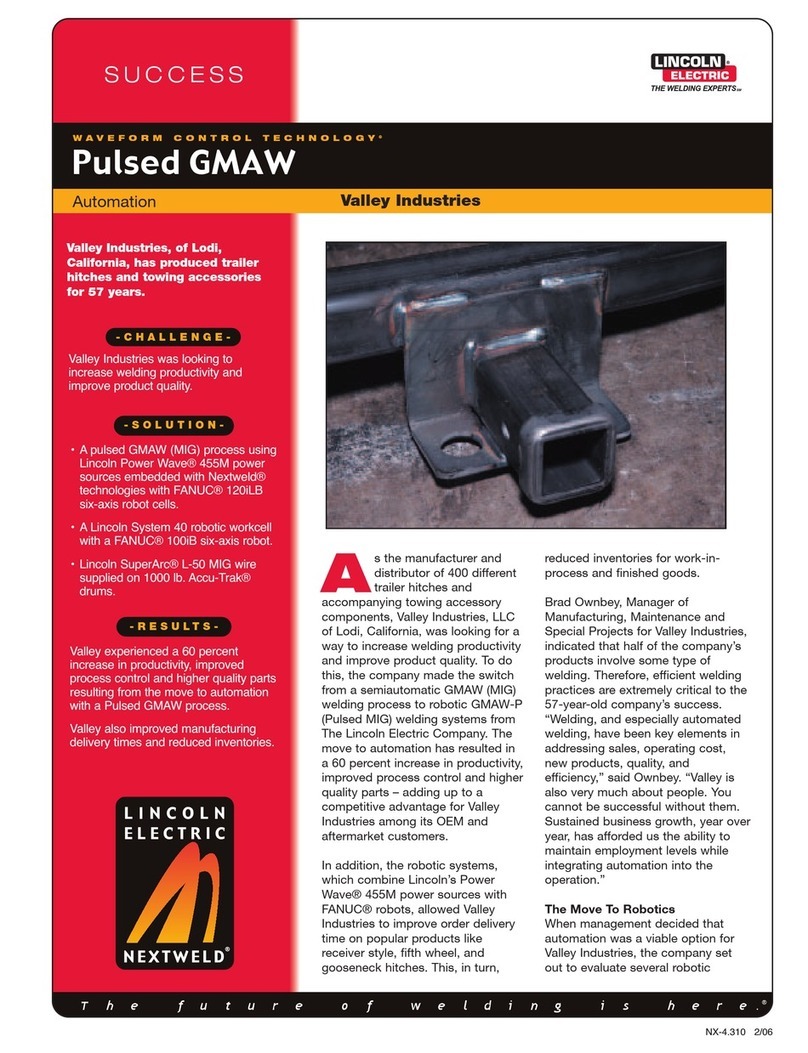
Lincoln Electric
Lincoln Electric Pulsed GMAW user manual

KOVO
KOVO EW240G Operation manual

Kemppi
Kemppi Kempact Pulse 3000 Service manual

Lincoln Electric
Lincoln Electric INVERTEC V160-S Service manual
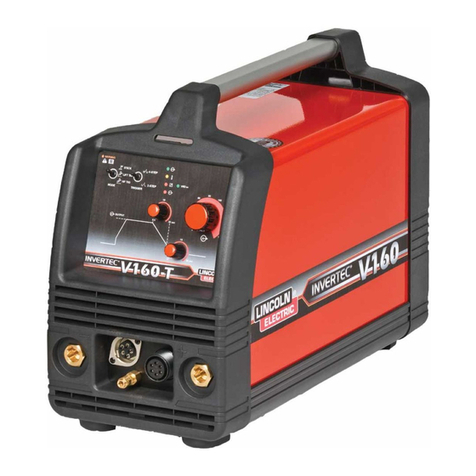
Lincoln Electric
Lincoln Electric INVERTEC V160 Service manual

Stealth
Stealth DIGI-TIG 320 AC/DC PULSE Operator's manual
